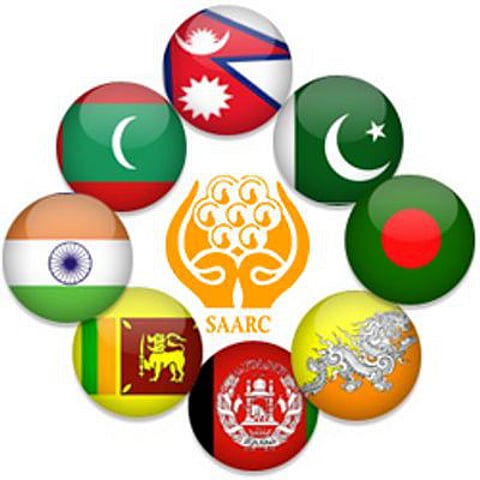Saarc has the potential to be a potent bloc
A south Asian security entity mandated to jointly confront terror networks can help create an atmosphere of cooperative regionalism in the region

When senior Indian and Pakistani officials attended the 53rd Programming Committee meeting of the South Asian Association for Regional Cooperation (Saarc) in Kathmandu earlier this month, many expected a thaw in India-Pakistan tension. The first one to be held after the postponement of the 19th summit in Islamabad last year due to terror attack on Indian Army bases, this meeting considered among other issues, restoring normal business necessary for realising the collective aspirations of 1.8 billion people.
But then, despite their best efforts, the current impasse could not be resolved, which may eventually jeopardise the appointment of senior Pakistani diplomat Amjad Sial as Saarc’s 13th secretary-general this month-end. It is a pity that a region accounting for a fourth of humanity and faced with many challenges is unable to foster a cooperative relationship. After all, it is an undeniable fact that regional groupings are the building blocks of the emerging global order. And Saarc, according to Ambassador Ahmad Saleem, ex-secretary-general of the organisation, can reshape this volatile and unpredictable region and the future of its inhabitants, deserving a better deal.
Yet, an unspoken fear of Indian hegemonic domination has taken a toll on south Asia’s only multilateral forum, capable of satisfactorily dealing with the myriad problems of poverty, terrorism, water crisis, food security, climate change, drugs proliferation et. al.
As India’s first director at the Saarc Secretariat, Ambassador Amitava Tripathi puts it candidly, “SARRC is overwhelmingly Indo-centric. India accounts for over 75 per cent of its land mass and population and over 80 per cent of its GDP. Our vast range of products and services simply dwarfs [that of] all [other] Saarc countries put together and this in turn provokes fear and resentment.”
Differences between two members should not impede Saarc’s functioning because there are others who have a stake in it, says Ambassador Saleem, while advocating the effective use of the forum to facilitate India-Pakistan rapprochement, overcoming dark shadows of mistrust.
Inherent peacebuilding capacity
South Asia’s retarded regionalism may have been a handicap for policymakers in delivering tangible political and economic benefits through jointly conceptualised projects, but there is still scope for extricating Saarc from the mess it finds itself in. As Ambassador Kedar Shrestha, Nepal’s former foreign secretary and the country’s first director at the Saarc Secretariat laments, “Saarc has not been able to touch the minds and hearts of the man on the street.”
He believes there is scant reason to rejoice about any progress in core areas of economic development, poverty reduction, trade, investment, connectivity, movement of goods and people.
“There have been many laudable resolves, decisions and agreements but almost all of them have fallen by the wayside due to poor or non-implementation,” asserts Ambassador Shrestha.
Ambassador Tripathi agrees, adding, Saarc is poised on the edge of a precipice as the desire for regional cooperation loses steam worldwide.
However, not everybody has given up on Saarc. A highly-placed Pakistani diplomat with previous experience of serving in the Saarc Secretariat feels that south Asia has enough resources and adequate legal instruments that can be utilised to promote socio-economic emancipation. Most importantly, Saarc provides a perfect platform to extinguish inflamed passions and reconcile disparate positions.
Unfortunately, Saarc’s inherent peace-building capacity has been missing from popular discourse for some time now. It has remained witness to Indo-Pakistan reconciliation on many an occasion. In 2002, just three weeks after the parliament attack in India, the Saarc forum enabled the then Indian premier A.B. Vajpayee and Pakistani President Pervez Musharraf to shake hands publicly. Even when tensions between India and Pakistan were at their peak in 2010, it was once again at a Saarc event that Indian Premier Manmohan Singh met his Pakistani counterpart Yousuf Raza Gilani to try and stabilise a rocky relationship that has existed since 1947.
Way forward
Saarc is still alive. The duty to bring dynamism to the organisation and its activities, by harnessing the full potential, lies with the member states. Surely, having delegates transiting through places like Dubai, Doha, Singapore or Bangkok to attend Saarc meetings does not enhance the image of the forum. Rather, a lack of mutual trust and confidence, as well as open hostilities, have remained major stumbling blocks. To overcome this, the sensitivities of all stakeholders need to be addressed.
While New Delhi should not get in the way of a Pakistani diplomat assuming the secretary-general’s post on untenable grounds — given that on three previous occasions (1989, 1996 and 2012) secretaries-general were appointed without the formal consideration or nomination of Saarc Council of Ministers. India’s apprehension about efforts to grant China full membership must not be overlooked either.
Let us not forget that the humane and tolerant values of south Asian civilisations have enabled the regional leadership to articulate grand visions of inclusion and participation.
Hence, there is no reason why a common Saarc response to critical issues cannot be evolved and placed on the global stage. Ambassador Shrestha advocates concentrating on a unique theme “together we would do better” for inculcating a Saarc-psyche or ethos. And quite significantly, all the experts believe, a south Asian security entity mandated to jointly confront terror networks can help create an atmosphere of cooperative regionalism in the region, apart from strengthening the existing Saarc convention on terrorism.
Seema Sengupta is a Calcutta based journalist and columnist
Sign up for the Daily Briefing
Get the latest news and updates straight to your inbox



